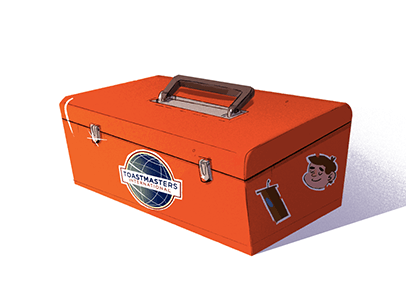 Illustration by Bart Browne
Illustration by Bart BrowneClick play to hear author Bill Brown, DTM, provide more tips on using cadence in your speech.
Have you ever been sitting somewhere, and music was subtly playing in the background? Did you find yourself tapping your feet to the beat? We all have. It is a natural human reaction. We like rhythm. And we respond favorably to it.
The spoken word is very similar. In fact, it has as much in common with a song as it does a written document. Yes, it is filled with words, but words can have cadence—a rhythmic pattern. And this cadence can be very important, especially in key phrases.
Do you have a takeaway line in your speech, a short phrase you repeat throughout that you want your audience to remember? Give it cadence.
Do you have a tagline in mind for your business? Give it cadence.
Are you using a rhetorical device in your speech, like a triad (a grouping of three things)? Give it cadence.
Or are you competing in a Toastmasters speech contest and want to avoid tripping over your lines? Give them cadence. They will be much easier to say and remember!
Cadence is formed by two factors—the syllables and the emphatic pattern.
First, the syllables. Obviously, some words have one syllable, others have more. The number of syllables affects the cadence and is very important in developing our phrases. More on that later.
Emphatic pattern has to do with the stress that we put on each syllable. Some syllables have what I will call a hard emphasis. Others have a soft emphasis. For instance, I am typing this on a computer. When I say “computer,” the emphasis is on the second syllable. That is what I call a hard emphasis. The other two syllables have a soft emphasis. Try saying it with the hard emphasis on the first syllable. It sounds weird, doesn’t it? Each word has its own natural cadence.
Let’s look at some examples.
One of my favorites is the famous line from the movie The Wizard of Oz. “Lions and tigers and bears. Oh, my!” The emphatic pattern is hard, soft, soft, hard, soft, soft, hard, <pause>, soft, hard. Say that phrase several times. Do you sense the inherent cadence? In fact, Dorothy and her friends marched through the forest as they chanted it. But the phrase is grammatically incorrect. If we were to follow what we were taught in school, we would say, “lions, tigers, and bears.” Adding an “and” after “lions” is bad English. But leaving it out is bad cadence. It is needed for the line to sing.
From the same movie, we find “the Wicked Witch of the West.” Do you sense the cadence? Notice that the pattern is soft, hard, soft, hard, soft, soft, hard. In this case, the two adjacent soft syllables are short and are spoken quickly, almost as one. As such, they serve as one beat in the cadence.
Cadence creates a memorable phrase, takeaway line, or tag.
A number of years ago I was writing a speech in which I talked about principles, perspectives, and paradigms—and I used that exact phrase. Do you sense the problem there? The emphatic pattern is off. The parallelism between the three factors is nonexistent. I switched the words around to “principles, paradigms, and perspectives.” The first two words now exhibit the same pattern. The first syllable in “perspectives” coalesces with “and,” creating a strong cadence that seems natural.
But what about the number of syllables? My wife and I have friends named Joan and David. If I say their names in that order, we have a strong cadence—hard, soft, hard, soft. If I say them in the reverse order, we lose that cadence. It is still correct, and you would still know who I am talking about, but the phrase just doesn’t sing. It’s also harder to say. Try it yourself. While the difference may be subtle, it is there.
Cadence is, perhaps, unique among the speaking skills. It is less analytical and more by feel. But, as I said at the start, we all respond to rhythm. You feel it, just like I do.
This concept is a bit harder to understand than most speaking techniques, but it is possibly one of the most important. It is involved in creating a memorable phrase, takeaway line, or tag. And it can make the difference between being long remembered or quickly forgotten.
The Wizard of Oz came out 83 years ago, yet we are still quoting lines from it. “Lions and tigers and bears. Oh, my!” Speak so as to be remembered.
Bill Brown, DTM is a speech delivery coach in Gillette, Wyoming. He is a member of Energy Capital Toastmasters in Gillette. Learn more at billbrownspeechcoach.com.



 Previous
Previous

 Previous Article
Previous Article
